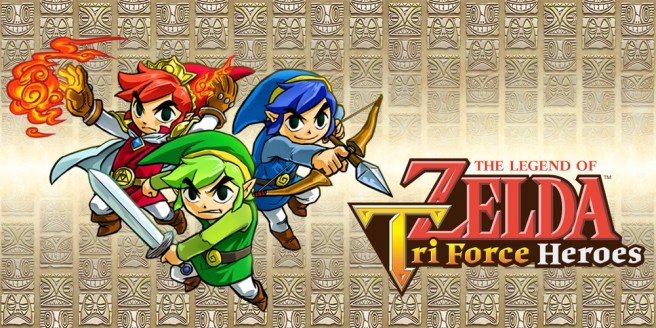Zelda: Tri Force Heroes – story, no overworld map, game length, and more
The latest interview concerning The Legend of Zelda: Tri Force Heroes has come from Kotaku, who spoke with director Hiromasa Shikata. Shikata discussed the game’s story (and why the different characters all look like Link), confirmed that there is no overworld map, touched on the game length, and more.
As usual, you can head past the break to see what Shikata said. You can also give Kotaku’s piece a look here.
On where the whole thing came from…
“It starts with [Zelda producer Eiji] Aonuma. Once he did Four Swords, he wanted to revisit multiplayer at some point.”
On how Shikata took some inspiration from Link working in tandem with Phantom Zelda in Spirit Tracks…
“I thought, ‘wow, this multiplayer thing has appeal to it.’ And then of course when we were working on Link Between Worlds, Mr. Aonuma and I were both commenting on how we both wanted to experiment with some multiplayer action, and that’s really where this project gets its start.”
On whether multiplayer was ever considered for A Link Between Worlds…
“We never thought about that.”
On the story…
“The story takes place in a kingdom that is obsessed with fashion, and within the kingdom there’s a happening, an event, and as a result of that the king sends out a notification asking for heroes to assemble.”
On why the three different people all look like Link…
“That’s a pretty deep question. The king is a firm believer in this legend, in this prophecy that exists within their kingdom, of three heroes that come together to form a totem. The king understands from this legend that describes the true hero as someone with these long sideburns and this particular hair style and these long ears. So the king from amongst these people is able to find the correct ones. The people who meet his conditions are the true heroes.”
On playing alone…
“One thing that stands out when you’re playing single-player, even though it’s the same course, when you’re playing as one person, because of the gameplay style, it’s inherently more puzzle-like.”
On voice chat…
“We did actually think about some simple voice chat implementation, actually. One thing we supposed would happen is that you’d highlight a gap between the experience levels of players. For example, if you’re playing with me and you’ve been playing Zelda forever and you’re very experienced, we’d get on and it’d be a case of pretty soon you’d be like, ‘Go do this, don’t do this, pick up this, don’t do this.’ And as the inexperienced guy, I’d be like, ‘OK I guess I’ll do whatever you’re telling me to.’ And really for both of us the enjoyment level drops dramatically.”
On using the different icons on the touch screen to communicate…
“I think with these, for example, you can just be sitting there hitting the one icon that you want: ‘Hey, we have to get in a totem here, totem here,’ or ‘Use that item, use that item, use that item,’ or ‘Hey, come here, come here,’ whatever it is. For those people who are in the mood to do so, they will cooperate, and sometimes maybe they’re not going to be listening to you, no matter how many times you send out the same message.
“I think we’re seeing a really unique form of communication in that because it can be a little difficult using just eight icons to communicate some complicated ideas. When you’re able to—through your choice, and which panel, and what timing, and what order you’re selecting them in—be like, ‘Wow, I actually made my point,’ you feel pretty happy when the person does what you just asked them to do.
“But on the other side, the person who’s like watching you hit all these different icons and goes, ‘Oh wait, I think he wants me to come over here, use this thing to do that thing,’ and you go over and you do it and it works, there’s a sense of satisfaction on both sides that you’re not gonna see in a game that has maybe a regular voice-chat implementation.
“I really think, again, that satisfaction you get time and time again when you’re able to communicate effectively on both sides, from conveying the information and receiving the information, the more you are able to succeed at doing that, and as you progress in the game based on that, it really really heightens that sense of satisfaction, and really matches the sense of cooperation we’re trying to focus on in this game.”
– No overworld map
– There will be a castle, a town, and a colisseum battle mode
On why the health bar is shared across all three Links…
“Because it’s better.”
– Can save at any time
– The game will automatically save if someone drops out
On the game’s length…
“I think it’s a little difficult to answer. I could probably say if it’s one person just on their own sitting down we might be able to calculate it out, but when you have three people, the way they play [and] how they play makes a difference.
“Myself I’d like to say maybe an hour a day, an hour and a half to two hours a day, with three people playing together, there’s probably about a month’s worth of gameplay there.
“But there are a lot of extra elements and things you can do in this game. If you’re a completionist, you’re gonna be playing for a long time.”
